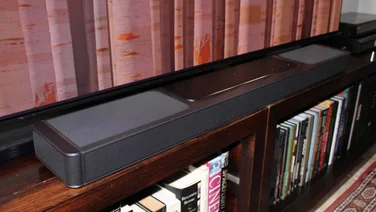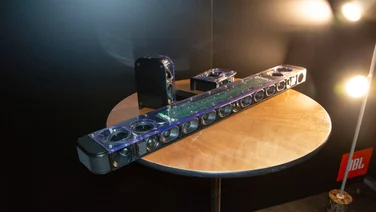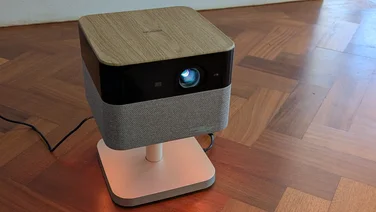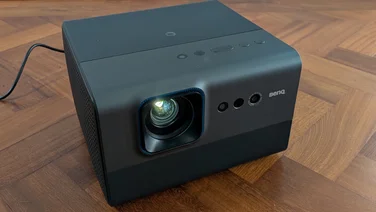To help us provide you with free impartial advice, we may earn a commission if you buy through links on our site. Learn more
- Expert Reviews has tested 37 projectors since the start of 2023, ranging from budget FHD options to premium native 4K beamers.
- Each projector we review undergoes a range of objective and subjective tests to assess its performance across key areas, including picture quality, audio quality and smart functionality.
- Our favourite projector overall is the Hisense C2 Pro, which delivers strong 4K HDR performance and powerful audio in an easy-to-use package.
- Those looking for something cheaper and more compact should consider the Anker Nebula Capsule 3, a pint-sized projector that produces vibrant 1080p images.
- There are plenty of other great options available, catering to a range of needs. Read on to find the best projector for you, no matter your budget.

Projectors come in all shapes and sizes and can cost anywhere from a couple of hundred quid to many thousands of pounds. We’ve tested numerous options across this wide range of prices and, as much as it pains us to say it, the more you pay, the better picture you tend to get.
However, you don’t have to spend a fortune to enjoy an immersive big-screen TV show, movie, or sports experience at home; there are plenty of great-value projectors out there. Below you’ll find the models we recommend for a range of needs and budgets.
If you require more information before making a purchase, our buying guide at the bottom of the page will arm you with all the knowledge you need to decide which projector is right for you as a large-screen TV alternative.
READ NEXT: Projector vs TVs
Best projector: At a glance
- Hisense C2 Pro: Best projector overall | Check price
- Nebula Capsule 3: Best budget projector | Check price
- XGIMI MoGo 4 Laser: Best portable projector | Check price
- BenQ X500i: Best projector for gaming | Check price
How we test projectors
We test all projectors by setting them up from scratch in a darkened room with an 80in to 100in screen. We set up and configure the projector, ironing out any focus or geometry issues, and, where a projector has built-in streaming features, we will install a range of streaming apps, including Netflix, Amazon Prime Video, YouTube and Disney+. Where projectors lack such features, we have a Roku 4K Streaming stick with the apps pre-installed.
We then use the projector to watch a range of test material, including blockbuster movies, popular streaming series and drama or documentary shows. We also use any built-in Chromecast or screen-mirroring features to cast 1080p or 4K video directly from an Android tablet or smartphone. On premium 1080p and 4K projectors, we also run additional tests using a 4K Blu-ray player and a PlayStation 5 console. This will reveal how the projector handles high-quality sources, not to mention high-refresh modes or 4K gaming.
We also test any built-in speakers at low, medium and high volume levels, and run portable projectors on battery power, where available, to see how long the battery lasts. Finally, we use a colorimeter, mounted on a tripod 30cm from the screen, to check brightness and contrast levels, colour accuracy and colour depth.
The best projectors you can buy in 2025
1. Hisense C2 Pro: Best projector overall
Price when reviewed: £1,599 | Check price at Amazon

- Great image quality
- Powerful audio
- Easy to use
- Limited app selection
The Hisense C2 Pro is our top projector pick as it ticks all the key boxes extremely well and does so at a very fair price. First and foremost, its 4K HDR pictures are bright and rich. We measured 93% coverage of the DCI-P3 gamut used in HDR, which is a terrific result. Images can be beamed up to an enormous 300in, and the C2 Pro can put out 2,600 ANSI lumens of brightness; enough to deliver detailed pictures with daylight in the room.
Its VIDAA software, which will be familiar to those who have used a Hisense television, is straightforward to navigate, and supports major global streaming apps, including Netflix, Prime Video and Disney+. A low-latency gaming mode, support for 120Hz at 1080p and brilliant audio at moderate volumes make this a best-in-class all-rounder.
Read our Hisense C2 Pro review from January 2025
Key specs – Resolution: 4K (1080p native); Brightness: 2,600 ANSI lumens; Contrast ratio: 2,000:1; Throw ratio: 0.9–1.5:1; Zoom: 1.67x; Light source: RGB Laser; Lifespan: Up to 25,000 hours
2. Nebula Capsule 3: Best budget projector
Price when reviewed: £360 | Check price at Argos

- Vibrant 1080p images
- Very compact
- Google TV streaming
- Short battery life
- Angle can’t be adjusted
Not only is the Nebula Capsule 3 our favourite budget projector, but it’s also the most compact option on this list. Don’t underestimate it based on its size, however. We measured sRGB and DCI-P3 colour gamut coverage figures of 91.4% and 74.8% – superior scores to many larger projectors – and the Capsule 3 reproduces colours in a dark room very effectively as a result.
Onboard Google TV smarts make accessing content via the Capsule 3 a doddle, and all of the major UK catch-up apps are present and correct, which is very welcome. Also welcome is the volume this can-shaped beamer creates; we really enjoyed its ability to communicate warmth, detail and plenty of welly when big-screen blockbusters require it.
Read our Nebula Capsule 3 review from January 2024
Key specs – Resolution: 1080p; Brightness: 200 ANSI lumens; Contrast ratio: 400:1; Throw ratio: 1.2:1; Zoom: Yes; Light source: LED; Lifespan: Up to 30,000 hours
3. Sony VPL-XW5000ES: Best native 4K projector
Price when reviewed: £4,499 | Check price at Richer Sounds

- Supremely detailed 4K images
- Effective tone mapping
- Compact and stylish build
- Lens controls are manual
- Doesn’t support HDMI 2.1
The Sony VPL-XW5000ES combines cutting-edge SDR and HDR performance with a great design, making it the best native 4K projector we’ve tested. Unlike the other options on this list, it doesn’t use pixel shifting; Sony’s SXRD display technology beams images in full 3,840 x 2,160 resolution. Those images look gorgeous and are very accurate, too. In Reference mode, we measured Delta E errors for greyscale and colour at 2.6 and 1.7, respectively. If you choose to calibrate the projector, you can get these below 1.
Motion is handled brilliantly, Sony’s Reality Creation sharpens pictures in an incredibly sophisticated manner, and frame-by-frame HDR tone mapping helps deliver punch and detail. The laser light source is bright enough for most viewing situations and won’t dim significantly over its lifespan, making this not only the best native 4K choice, but one that will stand you in good stead for years to come.
Read our Sony VPL-XW5000ES review from August 2022
Key specs – Resolution: 4K; Brightness: 2,000 ANSI lumens; Contrast ratio: 10,000:1; Throw ratio: 1.38-2.2:1; Zoom: 1.6x; Light source: Laser; Lifespan: Up to 20,000 hours
4. XGIMI MoGo 4 Laser: Best portable projector
Price when reviewed: £679 | Check price at Amazon

- Supremely convenient
- Ingenious design
- Impressive picture performance
- Battery life could be better
The MoGo 4 Laser’s clever design is a major factor in our selection of it as the best portable projector. At a touch over 20cm tall, it’s very easy to transport, its in-built battery lasts around two hours – enough for a reasonable-length film – and the way it can be rotated through a full 360 degrees allows it to project onto just about any surface.
That flexibility is backed up by great picture performance thanks to the triple laser light source. This enables the MoGo 4 Laser to reach brightness levels visibly above those of its similarly priced competitors, levels that had us questioning whether XGIMI was underselling the projector by stating luminance at 550 ISO lumens. In addition to its engaging pictures, the MoGo 4 Laser can be transformed into a Bluetooth speaker or project ambient visuals. Vibes.
Read our XGIMI MoGo 4 Laser review from July 2025
Key specs – Resolution: 1080p; Brightness: 550 ISO lumens; Contrast ratio: 1,000:1; Throw ratio: 1.2:1; Zoom: Yes; Light source: Laser; Lifespan: Up to 20,000 hours
5. Nebula X1: Best projector for sound quality
Price when reviewed: £2,200 | Check price at Amazon

- Immersive sound
- Fantastic image clarity
- Simple to set up
- No BBC iPlayer
The Nebula X1’s pair of 15W woofers and two 5W tweeters create a better audio experience than any other projector we’ve tested. Still, we highly recommend buying the £499 accessories bundle, which includes two satellite speakers, two karaoke mics and a carrying case.
Doing so takes the X1’s sonic performance to epic levels. The combination of forward-, upward- and side-firing drivers helps create a much wider and deeper soundstage and delivers a home audio experience capable of giving some soundbars a run for their money. The picture quality is impressive too; we measured coverage of the DCI-P3 HDR gamut at a whopping 89% and the scale and detail of images proved breathtaking.
Read our Nebula X1 review from May 2025
Key specs – Resolution: 4K (1,080p native); Brightness: 3,500 ANSI lumens; Contrast ratio: 5,000:1; Throw ratio: 0.9-1.5:1; Zoom: Yes; Light source: Laser; Lifespan: Up to 30,000 hours
6. Samsung Premiere 9: Best ultra-short throw projector
Price when reviewed: £4,299 | Check price at Samsung

- Super-accurate Filmmaker mode
- Amazing colour coverage
- Great sound
- Expensive
Ultra-short-throw projectors produce big images from next to no distance away from a wall, and the Samsung Premiere 9 does so better than any other option we’ve tested. It can fill a 130in screen from just 24cm away, and does so in a uniformly well-defined and quiet fashion. We measured noise levels of just 26dB when sitting at a sensible distance from the Premiere 9 and peerless gamut coverage figures of 100% for DCI-P3 and 92% for BT.2020.
Filmmaker mode accuracy was superb: using our measurement tools, we recorded greyscale and colour Delta E errors of below the visible threshold of three, and sound quality is top-notch, too. Samsung’s Tizen operating system is stuffed full of useful features and is the icing on this amazing ultra-short-throw cake.
Read our Samsung Premiere 9 review from September 2024
Key specs – Resolution: 4K (1,080p native); Brightness: 3,450 ISO lumens; Contrast ratio: 1,700:1; Throw ratio: 0.189:1; Zoom: Yes; Light source: RGB Laser; Lifespan: Up to 20,000 hours
7. XGIMI Horizon S Pro: Best-value 4K projector
Price when reviewed: £1,189 | Check price at Currys

- Dazzling colour performance
- Couldn’t be easier to set up
- Impactful audio
- Not particularly bright
- Occasional soap opera effect
A combination of aggressive pricing, engrossing pictures, and immersive audio quality makes the Horizon S Pro our recommendation for those looking for a great-value 4K projector. The S Pro is particularly good at rendering colours, reproducing 93.5% of the DCI-P3 gamut with Delta E accuracy errors below two, which means any discrepancies can’t be seen with the naked eye.
The audio setup was so clear, powerful and immersive that at times during films, we felt sound was coming from separate left and right speakers rather than 2 x 12W Harman Kardon drivers in the middle of our coffee table. If you want pixel-shifted 4K pictures and bang for your buck, this is the projector to buy.
Read our XGIMI Horizon S Pro review from April 2025
Key specs – Resolution: 4K (1,080p native); Brightness: 1,800 ISO lumens; Contrast ratio: 1,900:1; Throw ratio: 1.2:1; Zoom: Yes; Light source: LED and Laser; Lifespan: Up to 20,000 hours
8. BenQ X500i: Best projector for gaming
Price when reviewed: £1,375 | Check price at BenQ

- Three specific game modes
- Low input lag
- Effective HDR
- Lacks brightness
The X500i truly shines when paired with a current-gen console or other modern gaming device. Lightning-fast input lag of 4.2ms across three different Game modes ensures it’s super snappy and responsive, and this mode switches on as soon as a gaming source is detected, which is a nice touch.
The three Game modes all had a positive impact on our experience, too. Visuals were more cinematic and audio was bassier in RPG mode; SPG brightened colours and enhanced commentary on sports games, while FPS improved clarity in darker areas and positioned audio cues more accurately. If there’s a reasonably priced 4K projector with as impressive a gaming feature set as the X500I, we’ve yet to test it.
Read our BenQ X500i review from March 2024
Key specs – Resolution: 4K (1080p native); Brightness: 2,200 lumens; Contrast ratio: 1,350:1; Throw ratio: 0.69-0.83:1; Zoom: 1.2x; Light source: LED; Lifespan: Up to 30,000 hours
9. Nebula Mars 3: Best outdoor projector
Price when reviewed: £800 | Check price at Currys

- Easily carried around
- Impressive battery life
- Strong image quality
- Some UI frustrations
The Nebula Mars 3 nailed our battery-life test, lasting over five hours in Eco mode while streaming on Netflix. That exceptional stamina is just one of several reasons why it’s our favourite outdoor projector. Its integrated handle makes it easy to carry around, it’s a breeze to set up outside, it has a drop-resistant casing, and it has an IPX3 rating for water resistance, which is essential if you live in the UK.
The Mars 3’s rugged build provides it with a reassuring level of protection, its pictures display an impressive level of subtlety and tonal range, and its 40W three-speaker audio system packs a real punch. All of which makes the Mars 3 the perfect companion on road trips when a book just won’t cut it.
Read our Nebula Mars 3 review from September 2023
Key specs – Resolution: 1080p; Brightness: 1,000 ANSI lumens; Contrast ratio: 400:1; Throw ratio: 1.2:1; Zoom: Yes; Light source: LED; Lifespan: Up to 25,000 hours
How to choose the best projector for you
What resolution projector do I need?
If you’re looking for a projector to watch movies, make sure the model you buy is at least Full HD (1,920 x 1,080). You will come across plenty of cheaper office or portable projectors, but they’ll have limited resolutions of 800 x 600, 800 x 480, 1,280 x 720 or 1,024 x 768. As such, they might be fine for showing PowerPoint slides or streaming Netflix, but for sports, games and home cinema use, you really need to be able to watch 1080p content at the native resolution.
If you want a 4K projector, then expect to pay more. True 4K projectors with a native 4K resolution cost many thousands of pounds. However, there’s a growing number of projectors which simulate 4K by using pixel-shifting techniques with a 1080p panel. Purists will tell you that these aren’t really 4K, but the technology has reached a point where it’s near impossible to make a distinction – unless you have native and 4K enhanced models running side by side. Even then, you might find it a challenge.
How bright does a projector need to be?
This is such an important consideration that we’ve dedicated an entire article to answering the question: how many lumens does a projector need?
Things are complicated by different manufacturers stating different types of lumens values (ISO and ANSI), and how much brightness you need depends strongly on when and where you plan to use the projector and the ambient conditions.
However, a general rule of thumb is the more lumens, the better, though projectors with higher brightness typically cost a lot more than their dimmer counterparts.
What are DLP and LCD projector technologies?
Many home-theatre projectors are based on one of two technologies: DLP (Digital Light Processing) and LCD (Liquid Crystal Display). DLP projectors are more common and tend to deliver the most bang per buck, while LCD projectors tend to be larger and more expensive.
DLP projectors do have a downside, though. As most display colours sequentially use a spinning, segmented colour wheel (there’s the odd exception to this rule), they suffer from what’s called the “rainbow effect”, where small areas of the image appear to splinter into small rainbows when you shift your gaze from one side of the screen to the other. Some people are less sensitive to this than others, though, so if you haven’t experienced a DLP projector, make sure you get a demo before spending your money.
Lamp vs LED vs Laser: What’s the difference?
All projectors need a light source to function, and both the technologies mentioned above can use lamps or LED (light-emitting diodes). But there’s also a third source option: laser. Each has its pros and cons, which we’ve covered below:
- Lamp light source: Lower cost, high heat and noise generation, short lifespan.
- LED light source: Long life, compact, low noise and heat generation, low brightness.
- Laser light source: Ultra-long life, strong colours, high contrast, quiet, expensive.
What is throw ratio, and why does it matter?
Throw ratio reflects the relationship between the distance the projector is from the surface it’s projecting onto, and the width of the projected image. A projector with a larger throw ratio than another projector needs to be placed further away from the screen to achieve the same picture size.
- Long-throw projectors have a throw ratio greater than or equal to 1:1
- Short-throw projectors have a throw ratio less than 1:1 but greater than 0.4 :1
- Ultra-short-throw projectors have a throw ratio of less than 0.4:1
If space is tight, you might want to consider a short-throw or ultra-short-throw projector, which can create big images on your screen or wall from incredibly short distances – as little as 10cm for a 50in image in some cases. The downside is that the projected image tends to suffer more from geometric distortion.
What does keystone correction do?
One way a projector can overcome such distortion is by using keystone correction. This compensates for a projector not being positioned perpendicular to the surface it is projecting onto, which results in a trapezoid shape. Keystone correction tweaks the vertical and horizontal aspects of the images to create a rectangular shape that’s far more enjoyable to watch.
Many projectors offer automatic keystone correction, so you don’t have to worry about fiddling with the picture, while others provide manual tools with which you can adjust the picture yourself.
Do I need optical zoom and lens shift?
Once you’ve worked out what throw ratio is going to work best in your space, you’ll want to consider optical zoom and lens shift capabilities, which will have an impact on projector placement.
Optical zoom allows you to enlarge or reduce the screen without moving the projector, while lens shift lets you move it up, down, left and right without losing quality – or moving the projector physically. The cheaper the projector, the more limited these options will be.
What connections do I need?
This very much depends on what you plan on connecting the projector to, but HDMI, USB-C and USB-A ports are the main connections to look for.
USB ports enable you to plug in streaming sticks, which can be invaluable if the projector’s operating system lacks support for one or two of your favourite streaming services, while HDMI is the best way to connect laptops and games consoles.















